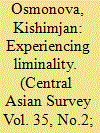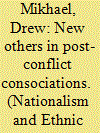| Srl | Item |
| 1 |
ID:
144351


|
|
|
|
|
| Summary/Abstract |
This article is intended to contribute broadly to research in post-socialist urban studies. Based on ethnographic fieldwork and interviews with ‘newcomers’ to the capital, Astana, from different parts of Kazakhstan, I examine the renting practices of newcomers. I analyse the experiences of newcomers in their new urban milieu of Astana, and try to answer the question of what it means to live in the city for various groups of individuals on a daily basis. I examine the Soviet and post-Soviet housing and the continuities of the Soviet legacy when it comes to the institution of propiska (city registration). I show that living in shared flats is a coping strategy to deal with expensive rents and meant to be a transitory step towards homeownership. For this reason many accept high rents and crowded housing as ‘normal’. Furthermore, I argue that informal renting practices are acceptable mostly for young and single people, who are free to experiment with city life, and are on their way to establishing careers and personal lives. However, elderly newcomers and young families with children who do not wish to live in shared flats, but have to rent, feel ‘homeless’ and trapped in ‘liminal housing’. For them, renting is undesirable, and they feel a sense of incarceration if they fail to secure housing.
|
|
|
|
|
|
|
|
|
|
|
|
|
|
|
|
| 2 |
ID:
147828


|
|
|
|
|
| Summary/Abstract |
�is article studies the relationship between social and spatial mobility
of new urban migrants and residents. �e objective is to present the
in�uences of the household registration system on the social mobility of
China’s new urban migrants through a comparison of the di�erences
and similarities between these two groups. Two data sets are adopted in
this article: the Blue Book of Youth Nos. 1 and 2 and in-depth interviews
conducted during the summers of 2009, 2010, and 2011.
�ematic analysis was employed to understand their social mobility
a�er spatial mobility. Results show that new urban migrants are relatively
vulnerable. While society generally expects them to assimilate
rather than achieve upward social mobility, the hukou system limits
their access to social welfare and security. Meanwhile, new urban residents
who have access to advantages consider themselves lower-middle
class in terms of consumption, and maintain certain flexibility to
further establish their social and economic status. In this article,
“opportunity” is a significant theme. New urban residents strive to
leverage their urban resident status to create individual wealth.
|
|
|
|
|
|
|
|
|
|
|
|
|
|
|
|
| 3 |
ID:
178077


|
|
|
|
|
| Summary/Abstract |
Debates on consociationalism seek to explain how and why prescriptive power-sharing can support successful ethnic conflict management in post-conflict societies and if the differences between liberal and corporate consociationalism affect system stability. At the same time, a new and growing body of work has begun to examine the previously under-considered effects of power-sharing on “Others,” that is, those communities not in alignment with the included ethnic groups. This paper adds to understandings of liberal and corporate consociational models and their impact on a specific type of Other – “newcomers” – through interviews with civil society organizations representing their interests. Current approaches to the liberal-corporate distinction do not reflect the impact of institutional design on newcomers navigation of power-sharing systems. Through a comparative analysis of newcomer engagement in (liberal) Northern Ireland and (corporate) Lebanon, this paper will reveal how institutional design cultivates path-dependent elite behaviors that negatively impact newcomers through different policy responses.
|
|
|
|
|
|
|
|
|
|
|
|
|
|
|
|